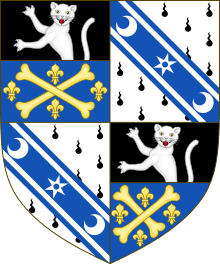Alfred Scott-Gatty
Sir Alfred Scott Scott-Gatty KCVO KStJ FSA (26 April 1847 – 18 December 1918) was a long serving officer of arms at the College of Arms in London and a successful composer.

Personal life
Alfred Scott-Gatty was born in Ecclesfield, now part of Sheffield, South Yorkshire with the given name of Alfred Gatty. He was the son of Alfred Gatty of Bellerby, Yorkshire who was serving as Vicar of Ecclesfield and his wife Margaret. Scott-Gatty was educated at Marlborough and Christ's College, Cambridge.[1] He assumed the name of Scott-Gatty in 1892, Scott being his mother's maiden name.
Heraldic career
Scott-Gatty began his heraldic career with his appointment as Rouge Dragon Pursuivant of Arms In Ordinary in 1880. He held that post for six years until his promotion to the office of York Herald of Arms in Ordinary. During his service as such he was in July 1901 appointed an Esquire of the Order of St. John (EsqStJ),[2] and in December 1903 promoted to a Knight of Grace of the same order.[3] Scott-Gatty was appointed Garter Principal King of Arms in 1904[4] and held that office until his death in 1918. It was under Scott-Gatty's control that the College of Arms reinstituted the process of granting badges to armigers. He was knighted for his services when he was appointed a Knight Commander of the Royal Victorian Order (KCVO) in June 1911, an honour personally bestowed by the King.[5]
Composing career
As a composer he was an amateur, but his work was popular and highly regarded in its day. The works that he produced were largely for voices and aimed primarily at amateur performers. It included two modest operettas, Sandford and Merton's Christmas Party (1880) and Not At Home (1886). It also included three musical plays specifically for children: Rumpelstiltskin, The Goose Girl (1895) and The Three Bears (1896). For the most part, these musical plays were set to words written by his sister, the noted children's writer Mrs Ewing. His songs ran into hundreds, many of them with texts by himself. A few of the best known titles were Ae Fond Kiss, Crofte and Ye Faire Ladye, True Till Death, and Country House Ditties (1898).
His concern to provide music for children, already noted, was pursued in Little Songs for Little Voices published in three volumes, including 76 short and simple songs. They were his earliest compositions and appeared in Aunt Judy's Magazine, edited first by his mother, then by his sister. Two of these songs, The Sneezing Song and Three Little Pigs were sung by Scott-Gatty himself in a concert at Doncaster Grammar School on 21 June 1870, long before they were published. He sang Three Little Pigs again in 1871 along with Camomile Tea, Tittle Tattle and The Yawning Song.
Scott-Gatty's most popular songs were the Plantation Songs (1893–1895) for baritone solo and mixed voice chorus. These included 24 songs in total, issued in four volumes. At that time such songs were novelties in the United Kingdom. The earliest recordings of Scott-Gatty date from December 1898 when the Georgia Glee Singers cut a version of Goodnight for the Gramophone Company, several other of the songs proved popular items with Melba in 1905 recording a version of the same song.[6] During the 1930s, long after Scott-Gatty's death, several of these were rearranged for baritone and male voice chorus by Leslie Woodgate and others had their accompaniments scored for orchestra by various hands. At least one of them, a duet, Good Night, was heard on 30 January 1891, years before it was published. It was performed in the Gattys' home territory in South Yorkshire, in a concert given in the surroundings of the Marble Saloon of Wentworth Woodhouse, near Rotherham, then the seat of Earl Fitzwilliam. It was sung by Scott-Gatty and his wife and the duet, according to a contemporary press report "caused a furore of enthusiasm."
Arms
 |
|
Succession
| Heraldic offices | ||
|---|---|---|
| Preceded by Sir William Henry Weldon |
Rouge Dragon Pursuivant 1880–1886 |
Succeeded by A.W. Woods |
| Preceded by John von Sonnentag de Havilland |
York Herald 1886–1904 |
Succeeded by George William Marshall |
| Preceded by Sir Albert William Woods |
Garter King of Arms 1904–1918 |
Succeeded by Sir Henry Farnham Burke |
See also
References
- "Gatty (post Scott-Gatty), Alfred (GTY867AS)". A Cambridge Alumni Database. University of Cambridge.
- "No. 27330". The London Gazette. 5 July 1901. p. 4469.
- "No. 27624". The London Gazette. 8 December 1903. p. 8112.
- "No. 27669". The London Gazette. 22 May 1904. p. 2582.
- "No. 28505". The London Gazette. 16 June 1911. p. 4595.
- "Search Results for". Charm.rhul.ac.uk. Retrieved 25 July 2020.
- Godfrey, Walter H; Wagner, Anthony (1963). "'Garter King of Arms', in Survey of London Monograph 16, College of Arms, Queen Victoria Street (London, 1963), pp. 38-74". british-history.ac.uk. Retrieved 2018-11-01.
External links
- CUHAGS Officer of Arms Index
- Works by or about Alfred Scott-Gatty in libraries (WorldCat catalog)